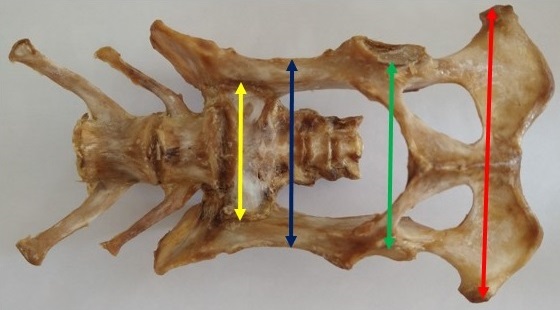Pelvimetry in bitches N.R.D. (no race defined)
DOI:
https://doi.org/10.21708/avb.2021.15.1.9759Abstract
Pelviology means the study of the pelvis, a structure formed by bones, ligaments and muscles. One of the subjects of pelviology corresponds to pelvimetry, which deals with the measurement of pelvic measurements, and which has a close relationship with reproduction. This study aims to verify the correlation between some body parameters and pelvic measurements. We used 50 N.R.D. female canine cadavers, varying in age and size, from euthanasia or natural death from the HOVET and Veterinary Clinics of the cities of XXX. Initially the body length, body height, thoracic perimeter, and body weight parameters were measured. Then, the bony pelvis was removed from the cadaver, sectioning the spine at the level between the lumbar vertebrae 5 (L5) and 6 (L6) and the femur in its middle third. Immediately after this procedure, the excess soft tissue was removed. In pelvimetry the following diameters were measured: thigh bone; transverse; acetabular; lateral ischiatic; true conjugate and vertical. The following mean values and standard deviation were obtained: 1) Body parameters: body weight (Kg) - 8.40 ± 5.86; height (cm) – 35.50 ± 11.76; body length (cm) – 48.60 ± 13.48; and thoracic perimeter (cm) – 43.80 ± 14.24; and 2) Pelvic diameters (cm): thigh bone – 3.313 ± 0.830; transversal – 3.864 ± 0.900; acetabular – 4.326 ± 1.140; lateral ischiatic – 7.171 ± 2.140; true conjugate – 4.720 ± 1.270; and vertical – 4.697 ± 1.270. Finally, it was verified that there is a significant positive correlation between body parameters and pelvic diameters
Downloads

Downloads
Pubblicato
Fascicolo
Sezione
Licenza
Autores que publicam na Acta Veterinaria Brasilica concordam com os seguintes termos: a) Autores mantém os direitos autorais e concedem à revista o direito de primeira publicação, com o trabalho simultaneamente licenciado sob a Licença Creative Commons Attribution que permite o compartilhamento do trabalho com reconhecimento da autoria e publicação inicial nesta revista. b) Autores têm autorização para assumir contratos adicionais separadamente, para distribuição não-exclusiva da versão do trabalho publicada nesta revista (ex.: publicar em repositório institucional ou como capítulo de livro), com reconhecimento de autoria e publicação inicial nesta revista. c) Autores têm permissão e são estimulados a publicar e distribuir seu trabalho online (ex.: em repositórios institucionais ou na sua página pessoal) a qualquer ponto antes ou durante o processo editorial, já que isso pode gerar alterações produtivas, bem como aumentar o impacto e a citação do trabalho publicado (Veja O Efeito do Acesso Livre).


 Esta obra está licenciada com uma Licença
Esta obra está licenciada com uma Licença 